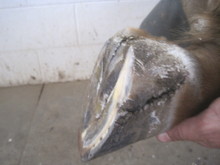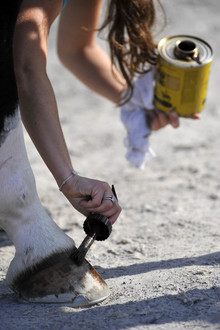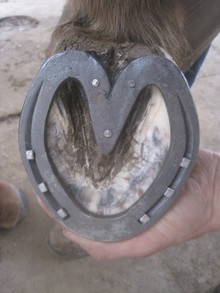
Hoof cracks can be identified by their location and depth. For example, a crack in the toe would be called a toe crack, and one in the quarter, is called a quarter crack. The severity of the crack, including its depth, can influence how it is treated. Some people use the old name sand crack. Cracks at the bottom of the hoof have a different cause compared to cracks that begin at the top of the hoof in the hair line.

A quarter crack
Each crack in a horse's hoof is individual and the results or repairing and stabilizing the hoof crack depend upon the type, location and treatment.
copy; 2015 by Jacob Butler
Hoof cracks are described, by their position. They can be vertical or horizontal. A horizontal crack is sometimes called a cleft and originates at the top of the foot due to an abscess that burst or tread wound at the hair line and then has begun to grow out.
What causes hoof cracks?
Injuries are common causes of hoof cracks. These types of cracks are a result of an injury from wire or a piece of machinery the horse gets into. Hoof growth originates from the top of the hoof similar to our finger and toenails.
When the growth origin is injured it affects the hoof ever after. If permanent line develops from top to bottom underneath an injury in the hairline this is called a false quarter. The foot might be weaker in this area. As the injury becomes dry and begins to crack, it is recommended that the owner apply Vaseline or bag balm to the coronary band to prevent drying out. Cracks often worsen from an injury that is not maintained.

Preventing worsening of cracks
As the injury becomes dry and begins to crack, it is recommended that the owner apply Vaseline or bag balm to the coronary band to prevent drying out.
copy; 2015 by Carien Schippers
A crack at the bottom of the foot can be caused by the horse stepping on something - then the foot breaks out. As a horse is trimmed a light bevel around the bottom edge of the foot is helpful for prevention. When a horse is shod this bevel is not necessary since the horseshoe provides protection. When a horse is left too long between trimming intervals, the feet could break off, sometimes shorter than what they would have been trimmed, making the horse sore or lame.
Horses should be trimmed regularly, depending on how fast the hoofs grow. The rate of growth is affected by heredity, season of the year and footing. Weight on various parts of the hoof also influences growth and wear.
Cracks at the hairline are typically more severe compared to cracks at the bottom of the foot even though the ones on the ground look worse. Underrun heels, which are primarily inherited, are caused by uneven weight on the horse's feet, producing an imbalance due to a broken back hoof pastern axis. This causes a long toe and low heel, which can result in a toe crack.
Another cause is a medial/lateral imbalance. This type of imbalance could produce quarter cracks due to stress and uneven weight bearing. This is where one side (medial) is higher than the other (lateral). Conformation is involved as it influences growth and wear.
The foot might grow more on the inside (medial) due to the fact that the weight is on the outside (lateral). For example, a pigeon-toed (fetlock varus) conformation turns in at the fetlock, producing more hoof growth on the medial side. A horse needs to be trimmed in balance regularly by an experienced farrier.
What are some treatment options?
There are several types of shoes that can be used for treatment of hoof cracks. Each crack must be assessed individually.
The heart bar shoe is helpful when treating cracks by taking the weight off of the sore or afflicted area and temporarily transferring it to the frog. The shoe's nail holes are placed in the forward half of the shoe away from the aggravated area. Generally, if it is a quarter crack this side is trimmed a little lower, this is called floating the heel - the heel does not touch the shoe.

Heart bar shoe - Helpful in treating cracks
The heart bar shoe is helpful when treating cracks by taking the weight off of the sore or afflicted area and temporarily transferring it to the frog.
copy; 2015 by Jacob Butler
Another problem can be if the foot is flexing or moving, causing irritation to the horse. A straight bar shoe provides rigidity to the hoof capsule. As the foot becomes more stabilized, the crack can grow out.
There are several types of modern patch materials used by professional farriers to aid in stabilizing a crack. It is important never to cover a crack with a patch that has any drainage coming out of it. This can cause an infection if a patch is placed over a crack that has some type of drainage, sealing up the wound, making it anaerobic, thus preventing oxygen from getting in.
Vettec has a variety of products for many different types of situations. Vettec Adhere can be used for cracks and hoof repairs. It can be applied directly to the foot, after the area around the crack has been prepared. It is important that the foot is dry and clean to ensure a good bond between the Vettec and the hoof.
Equilox is another material that can be used to repair and stabilize hoof cracks. There are different types that are slow Equilox I or fast Equilox II setting, giving one more time to apply. Equilox can also be applied with fiberglass. This can be done with different layers or by cutting up the fiberglass and mixing in with the Equilox.
Each crack is individual and results depend upon the type, location and treatment. After one shoeing interval with the combination of the patch material and shoeing, you will see new hoof growth below the hairline because the foot has been stabilized allowing the hoof to grow out. Cracks must grow out, since the wall is produced from the coronary band, they do not heal from the inside out.
By Jacob Butler CJF, AWCF and Doug Butler PhD, CJF, FWCF
